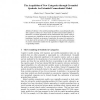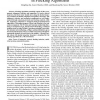92 search results - page 18 / 19 » A Simulation Environment for Middle-Size Robots with Multi-l... |
KESAMSTA
2010
Springer
13 years 10 months ago
2010
Springer
Abstract. In Multi-Agent System, observing other agents and modelling their behaviour represents an essential task: agents must be able to quickly adapt to the environment and infe...
ICANN
2003
Springer
13 years 10 months ago
2003
Springer
Abstract. Solutions to the symbol grounding problem, in psychologically plausible cognitive models, have been based on hybrid connectionist/symbolic architectures, on robotic appro...
INFOCOM
2009
IEEE
13 years 12 months ago
2009
IEEE
—Tracking mobile targets using sensor networks is a challenging task because of the impacts of in-the-filed factors such as environment noise, sensing irregularity and etc. This...
TFS
2008
13 years 5 months ago
2008
Abstract--Flocking algorithms essentially consist of three components: alignment, cohesion, and separation. To track a desired trajectory, the flock center should move along the de...
ATAL
2010
Springer
13 years 6 months ago
2010
Springer
Learning, planning, and representing knowledge in large state t multiple levels of temporal abstraction are key, long-standing challenges for building flexible autonomous agents. ...


